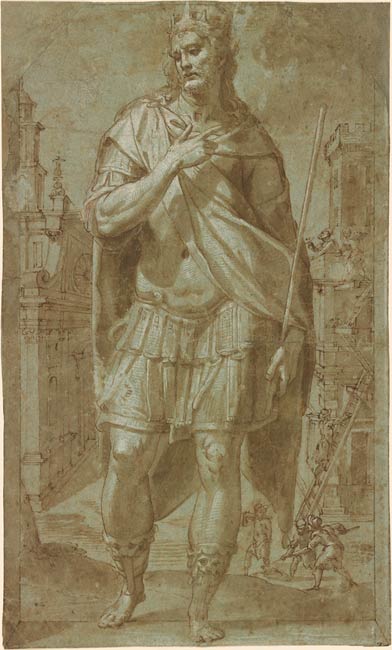
The identity of the artist of this luminous study continues to confound scholars. The drawing once bore on its mount (since removed and now in in the departmental file), an attribution to Aurelio Luini, inscribed in pen and ink in what appears to be a sixteenth-century hand. This was refuted by Giulio Bora in 1984 according to a note in the file. Attributions to Lorenzo Sabatini (by Mario Di Giampaolo, orally in 1997), and Orazio Samacchini (by Marzia Faietti and Aidan Weston-Lewis, orally in 2004) as well as Siciolante da Sermoneta (by Catherine Monbeig Goguel, orally in 2002), Girolamo Muziano, and Livio Agresti have been considered; more recently, an attribution to Paris Nogari has been tentatively suggested (by Scott Bacon, via email). To all appearances the drawing is Roman, dating from the period ca. 1565 to 1580. Some of the closest comparisons have been drawn to the work of Lorenzo Sabatini, who had come to Rome in 1573 to work on the decoration of the Sala Regia in the Vatican Palace. Compare for instance his study of The Blinding of Polyphemus in the Museum of Fine Arts, Budapest, preparatory for a fresco of 1570 (inv. 1968). The church depicted in the drawing, with a cross-section facade with scrolls, a triangular gable and pilasters, also supports a localization in Rome in the latter half of the sixteenth century. It follows a type that had been common in Rome since the late fifteenth century but was taken to new heights with Antonio da Sangallo the Younger's façade of Santo Spirito in Sassia, erected in 1590. The figure stands as if on a threshold before a backdrop of a church at left and of building activity at right, possibly for a fortified tower. He may represent King Nimrod, founder of Babylon and the Assyrian Empire, whose followers, according to the Old Testament, built the tower of Babel. Alternatively, the drawing may depict King Solomon, under whose command the temple in Jerusalem and a palace in the same city were erected. Presumably intended as part of a series representing great builders of antiquity, the study bears some similarity to a series of ten engravings of Persian Kings, made by Gerard de Jode in 1585, though there is no exact correspondence with any of the prints.
Watermark: none.
Inscribed in lower right corner, in pen and dark brown ink, "3[.]"; on verso, at upper center, in pen and brown ink, fragmentary and illegible character; on verso of old mount, now removed and preserved in departmental files, in pen and brown ink, "aurelio Luini"; and, according to departmental files, in purple pencil, "201"; in graphite, "36".
Luini, Aurelio, approximately 1530-1593, Formerly attributed to.
Calmann, Hans M., 1899-1982, former owner.
